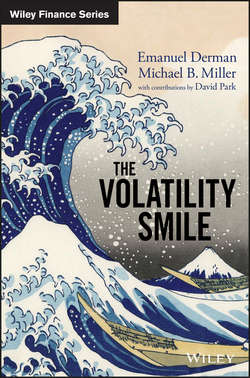Читать книгу The Volatility Smile - Park Curry David - Страница 11
На сайте Литреса книга снята с продажи.
Chapter 1
Overview
A Quick Look at the Implied Volatility Smile
ОглавлениеThe BSM model assumes that a stock's future return volatility is constant, independent of the strike and time to expiration of any option on that stock. Were the model correct, a plot of the implied BSM volatilities for options with the same expiration over a range of strikes would be a flat line. Figure 1.1 shows what three-month equity index implied volatilities looked like before the Black Monday stock market crash of 1987.
Figure 1.1 Representative S&P 500 Implied Volatilities prior to 1987
Prior to the crash, therefore, the BSM model seemed to describe the option market rather well, at least with respect to variation in strikes. Figure 1.2 shows typical three-month implied volatilities after the crash of 1987. Even though all the options used to generate the smile were written on the same underlier, each option had a different implied volatility. This is inconsistent with the BSM model, which assumes that implied volatility is a forecast of actual volatility, for which there can be only one value. You can think of options as metaphorical photographs of the stock's future volatility, taken from different angles or elevations. While photographs of a building taken from different points might look different, the actual size of a building remains the same. In a similar way, if the BSM model were truly reliable, the implied volatility of the stock would be the same, no matter which option you chose to view it with. The option price is derived from the stock price, but the stock's volatility should not depend on the option.
Figure 1.2 Representative S&P 500 Implied Volatilities after 1987
Though the smile appeared most dramatically in equity index option markets after the 1987 crash, there had always been a slight smile in currency option markets, a smile in the literal sense that the implied volatilities as a function of strike resembled one: . As depicted in Figure 1.2, the equity “smile” is really more a skew or a smirk, but practitioners have persisted in using the word smile to describe the relationship between implied volatilities and strikes, irrespective of the actual shape. The smile's appearance after the 1987 crash was clearly connected with the visceral shock upon discovering, for the first time since 1929, that a giant market could suddenly drop by 20 % or more in a day. Market participants immediately drew the conclusion that an investor should pay more for low-strike puts than for high-strike calls.
Since the crash of 1987, the volatility smile has spread to most other option markets (currencies, fixed income, commodities, etc.), but in each market it has taken its own characteristic form and shape. Traders and quants in every product area have had to model the smile in their own market. At many firms, not only does each front-office trading desk have its own particular smile models, but the firm-wide risk management group is likely to have its own models as well. The modeling of the volatility smile is likely one of the largest sources of model risk within finance.
